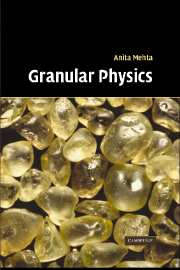Book contents
- Frontmatter
- Contents
- Preface
- 1 Introduction
- 2 Computer simulation approaches – an overview
- 3 Structure of vibrated powders – numerical results
- 4 Collective structures in sand – the phenomenon of bridging
- 5 On angles of repose: bistability and collapse
- 6 Compaction of disordered grains in the jamming limit: sand on random graphs
- 7 Shaking a box of sand I – a simple lattice model
- 8 Shaking a box of sand II – at the jamming limit, when shape matters!
- 9 Avalanches with reorganising grains
- 10 From earthquakes to sandpiles – stick–slip motion
- 11 Coupled continuum equations: the dynamics of sandpile surfaces
- 12 Theory of rapid granular flows
- 13 The thermodynamics of granular materials
- 14 Static properties of granular materials
- References
- Index
- Plate section
6 - Compaction of disordered grains in the jamming limit: sand on random graphs
Published online by Cambridge University Press: 06 October 2009
- Frontmatter
- Contents
- Preface
- 1 Introduction
- 2 Computer simulation approaches – an overview
- 3 Structure of vibrated powders – numerical results
- 4 Collective structures in sand – the phenomenon of bridging
- 5 On angles of repose: bistability and collapse
- 6 Compaction of disordered grains in the jamming limit: sand on random graphs
- 7 Shaking a box of sand I – a simple lattice model
- 8 Shaking a box of sand II – at the jamming limit, when shape matters!
- 9 Avalanches with reorganising grains
- 10 From earthquakes to sandpiles – stick–slip motion
- 11 Coupled continuum equations: the dynamics of sandpile surfaces
- 12 Theory of rapid granular flows
- 13 The thermodynamics of granular materials
- 14 Static properties of granular materials
- References
- Index
- Plate section
Summary
Granular compaction is characterised by a competition between fast and slowp degrees of freedom; far from the jamming limit, individual grains can quickly move into suitable voids in their neighbourhood. As the jamming limit is approached, however, voids which can accommodate whole grains become more and more rare; a cooperative rearrangement of grain clusters is required to fill the partial voids which remain. Such collective processes are necessarily slow, and eventually lead to dynamical arrest.
The modelling of granular compaction has been the subject of considerable effort. Early simulations of shaken hard sphere packings, carried out in close symbiosis with experiment, were followed by lattice-based theoretical models; the latter could not, of course, incorporate the reality of a disordered substrate. Mean-field models which could incorporate such disorder could not, on the other hand, impose the finite connectivity of grains included in Refs. It was to answer the need of an analytically tractable model which incorporated finitely connected grains on fully disordered substrates that random graph models of granular compaction were first introduced by Berg and Mehta.
A random graph consists of a set of nodes and bonds, with the bonds connecting each node at random to a finite number of others, thus, from the point of view of connectivity, appearing like a finite-dimensional structure. Each bond may link two sites (a graph) or more (a so-called hypergraph).
- Type
- Chapter
- Information
- Granular Physics , pp. 79 - 93Publisher: Cambridge University PressPrint publication year: 2007



